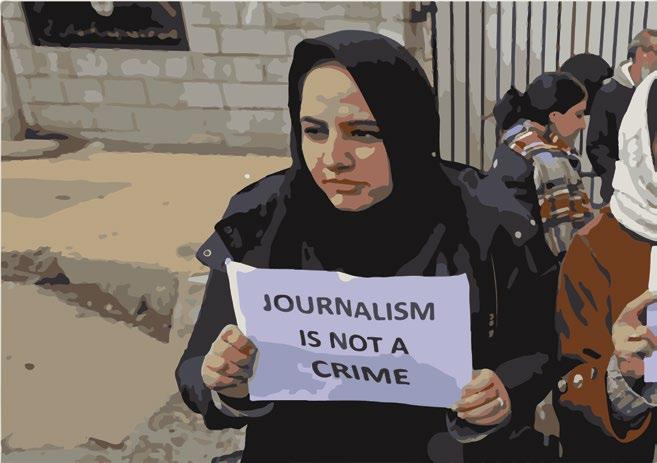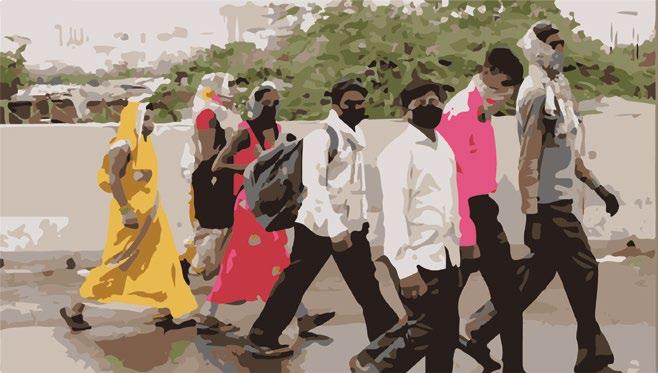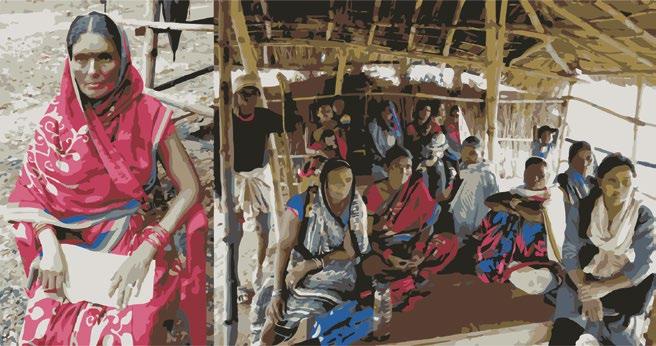
8 minute read
Attacks on Journalists
Gauri Lankesh was an Indian journalist-turned-activist, she was shot to death on 5 September 2017, by 3 unidentified men outside of her residence.
Freedom of the Press: Journalism under attack in India
Freedom of Press is one of the main tenets of a true democracy. Journalism is known as the Fourth Estate in a democracy; thus it is one of the pillars upon which a democracy stands. Freedom of Press has been interpreted within the ambit of freedom of speech and expression under Article 19(1)(a) of the Indian Constitution.
However, this freedom gets stifled when journalists are punished or booked for reporting the truth, that is not palatable to the either the government, or are killed by some anti-social elements for digging out truth and doing their job. India’s ranking in the World Press Freedom Index has been on a constant decline since 2010. While in 2013 and 2014, it was listed at 140 among the 180 nations, it climbed to 136 in 2015 and 133 in 2016. However, since 2017, it has begun yet again to decline – from 136 to 138 in 2018, 140 in 2019, to arrive at 142 in 20201 .
There is another report called the Global Impunity Index prepared by the Committee to Protect Journalists (CPJ) which was released in October 2019. This index highlights countries where journalists are murdered in the line of duty and the perpetrators go unpunished. The report states that between 1992 and 2020, 51 journalists have been killed in India and out of them 32 are cases where the culprits have virtually gotten away with murder!2
The New York Times also took a deeper look into freedom of the press
in India in an article titled Under Modi, India’s Press is not so Free anymore.3 The NYT piece said, “Mr. Modi has shrewdly cultivated the media to build a cult of personality that portrays him as the nation’s selfless savior. At the same time, senior government officials have pressed news outlets — berating editors, cutting off advertising, ordering tax investigations — to ignore the uglier side of his party’s campaign to transform India from a tolerant, religiously diverse country into an assertively Hindu one.” It adds, “With the coronavirus pandemic, Mr. Modi has gotten more blatant in his attempt to control coverage and, as with other difficult stories, some Indian news executives seem willing to go along.” When it comes to journalists being killed, it is observed that it is mostly those journalists who work in the hinterlands in regional language press reporting on crime and corruption.
Legislative background
There is no central law to protect or safeguard journalists. Maharashtra is the only state that has a law called the Maharashtra Media Persons and Media Institutions (Prevention of Violence and Damage or Loss to Property) Act, 2017 which provides for punishment up to three years or a fine of up to Rs 50,000 or both in case of attack on media persons on duty. The offences are cognizable and non-bailable. However, as of August 2020, the law has not been implemented. Chhattisgarh and Bihar, where several media persons have come under attack in the past, are also mulling a similar legislation for the safety of journalists.4
Keeping in mind the failing performance of India on the World Press Freedom Index, the government took cognizance of it and in May 2020 established an Index Monitoring Cell (IMC). This cell has been given the mandate of examining why India’s rankings have been falling in press freedom indices. The problem with this cell is that it will dissect the index that has ranked India poorly without admitting that there are, in fact, circumstances that have been inconducive to freedom of Press.
Judicial intervention
Looking at the history of cases against journalists, it seems like the courts have generally ruled in favour of freedom of press. Journalist Zubair Ahmed who was arrested by police in Andaman and Nicobar islands for questioning the reason for putting a family under quarantine, was granted bail by the local court.5 Further, Dhaval Patel, a Gujaratbased journalist who was charged with sedition for writing an article that said that the state’s Chief Minister may be replaced due to his ineptitude in handling the COVID-19 crisis, was granted bail by a Sessions Court.6
The Calcutta High Court granted bail to Safikul Islam, owner of ArambaghTV YouTube channel and Suraj Ali Khan, a reporter working for the web channel who were arrested for exposing the alleged unfair distribution of COVID-19 funds to private clubs by the state government.7
On the other hand, the courts have failed to bring justice to slain journalists over the years. The continuous study conducted by CPJ shows that since 1992 until 2020, only two cases of murder of journalists have been concluded with the culprits being held gtuilty, Jyotirmoy Dey (killed in 2011) of Midday and Ram Chander Chaterpatti (killed in 2002). The other 33 journalists and their families are still waiting for justice which may never come their way.
Current scenario
The cases of journalists being killed that received much media attention were those of J Dey, Gauri Lankesh and Shujat Bukhari. Between 2015 and 2020, 13 journalists have been murdered, all of whom belonged to regional or niche news media.8 However, killing is not the only tool used to silence the press. Journalists were specifically in danger during the COVID-19 pandemic, suffering death due to the disease and worse also being subject to lay-offs. Independent reports have collated frightening figures: 1,000 journalists were laid off in the months between March- August 2020 alone.9 Besides, governments even targeted individual, independent journalists exposing administrative ineptitude and corruption.10
The Kashmir conundrum
Journalists in Kashmir especially (and also Jammu) have been facing the heat decades, but far more sharply after August 5, 2019 when the Modi government in its second elected term, without democratic consultation, abrogated Articles 370 and 35A and changed the status of the state. Independent reporting by the media leads to summons from local police stations, warnings, threats, and of course charges accompanied in many cases with arrests.11 For several months, the newspapers in the Valley went to press without editorials and opedits. Many newspapers slashed their number of pages as they had been deprived of government advertisement. And the harassment of journalists became more vigorous.12
In April 2020, a female photo journalist in Kashmir valley, Masarat Zehra (26), was booked under the draconian Unlawful Activities (Prevention) Act, which empowers the government declare individuals as terrorists. Gowhar Gilani, journalist and author of the book Kashmir: Rage and Reason who writes for Germany’s public broadcaster Deutsche Welle13 was also targeted. A special communique from three UN Special Rapporteurs on May 12, 2020 (AL IND 8/2020) sums up the grave risk with which journalists in Kashmir function.14 Specifically, it names Zehra, Gilani, Naseer Ganai, working for a news magazine published out of Delhi and Peerzada Ashiq, special correspondent for an Indian newspaper, reporting out of Kashmir Valley. The Jammu and Kashmir administration recently approved the Media Policy,
Masarat Zahra, 26, a photojournalist from Kashmir, was charged under Unlawful Activites Prevention Act (UAPA). Registering her under such a strong case is an act of intimidation and silencing of the press.

2020 (the “Policy” or “Media Policy”) that sought to create a “sustained narrative on the functioning of the government in the media.” This has been met with widespread criticism and protest.15
The rest of India under a right-wing government faired only slightly better. On August 26, 2020 a Meerut journalist and his family was attacked in their home allegedly by a leader of regional political party, Bahujan Samaj Party. In August, 2020 Prashant Kanojia was picked up by the police from his home in Delhi in connection with a Tweet. Kanojia was accused of “disrupting communal harmony”. According to independent news portal The Wire, the First Information Report (FIR) released by the police “points to a deleted tweet URL and says, in its description of the alleged offence, that Kanojia’s tweet had shown Hindu Army leader Sushil Tiwari as saying the Ram temple in Ayodhya should not allow Dalits, STs and OBCs entry.” It is alleged that the video had been morphed. In north east Delhi, on August 11, three journalists including a woman staffer of Caravan magazine were attacked by a mob demanding that they delete footage about communal tension that broke out in the area after foundation stone laying ceremony of Ram temple in Ayodhya. A Webinar on September 5, co hosted by The Wire, SabrangIndia, Delhi Union of Journalists & Brihanmumbai Union of Journalists focussed on this plight.16
Enact a legislation penalizing attacks on journalists to safeguard freedom of press
Protect journalists from getting arrested in cases that emerge from their reporting, such as defamation, sedition, promoting enmity, by mandating preliminary inquiry before making arrest, while acquiring permission from Magistrate
Combination image of Narendra Dabholkar (left), Govind Pansare (center) and MM Kalburgi (right). According to Cen-tral Bureau of Investigation (CBI) charge sheet filed in September last year, Akolkar and Pawar, two members of the right-wing organisation Sanatan Sanstha, which is a Sangh Parivar (Saffron Family) gunned down the rationalist.

1) https://thewire.in/media/as-press-freedom-rank-falls-govts-new-index-monitoring-cellto-meet-on-thursday 2) The Road to Justice- Breaking the cycle of Impunity in the killing of journalists Committee to protect Journalists - https:// www.nytimes.com/2020/04/02/world/asia/modi-india-press-media.html 4) https://economictimes.indiatimes.com/news/politics-and-nation/maharashtra-onlystate-with-law-to-protect-scribes/ articleshow/72214265.cms?from=mdr 5) https://www.outlookindia.com/website/story/india-news-andaman-journalist-arrestedover-tweet-on-coronavirus-getsbail/351639 6) https://timesofindia.indiatimes.com/city/ahmedabad/journalist-gets-bail-in-seditioncase/articleshow/76049158.cms 7) https://www.ifj.org/fr/salle-de-presse/nouvelles/detail/category/pressreleases/article/india-calcutta-high-court-grantsbail-to-arambagh-tv-journalists.html 8) https://cpj.org/data/killed/asia/india/?status=Killed&cc_fips%5B%5D=IN&start_year=1992&end_year=2020&group_ by=location 9) https://www.newslaundry.com/2020/05/24/stop-press-how-covid-19-is-only-part-ofthe-media-layoffs-story; https:// www.pratidintime.com/covid-19-hits-tv-print-media-hard/ 10) https://www.thehindu.com/news/cities/Coimbatore/news-portal-founder-arrested-incoimbatore/article31418909.ece 11) https://www.thecitizen.in/index.php/en/NewsDetail/index/9/ 12) https://www.nationalheraldindia.com/india/journalism-in-kashmir-going-throughtough-times 13) https://www.nationalheraldindia.com/india/journalism-in-kashmir-going-throughtough-times 14) Signed by David Kaye (United Nations special rapporteur on the Promotion and Protection of the Right to Freedom of Opinion and Expression between August 2014 and July 2020), Leigh Toomey (UN Vice- Chair on Arbitrary Detentions) and Mary Laylor (UN Special Rapporteur on the situation of human rights defenders) the communique flags the enormous dangers under which the mwdia functions in that state. 15) The Policy effectively authorises the government to intervene and determine content that qualify as fake news, unethical content and or ‘anti-national activities.’ The Policy also allows the Directorate of Information and Public Relations (“DIPR”) to examine such content, on the basis of which journalists may be de-empaneled and have legal action taken against them. Where fake news or news ‘inciting hatred’ or ‘disturbing intra-community harmony’ is concerned, if so interpreted, journalists shall be proceeded against under the Indian Penal Code, 1860 or cyber laws. See: https://lawschoolpolicyreview.com/2020/07/31/kashmirs-media-policy-2020-crackdownon-freedom-of-expression/ 16) https://sabrangindia.in/video/attack-free-speech-times-covid-19










